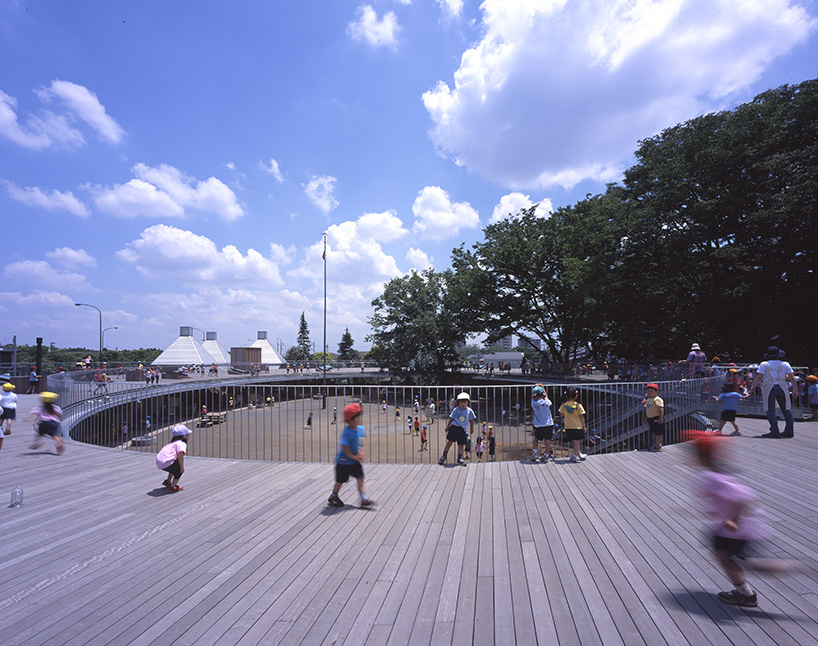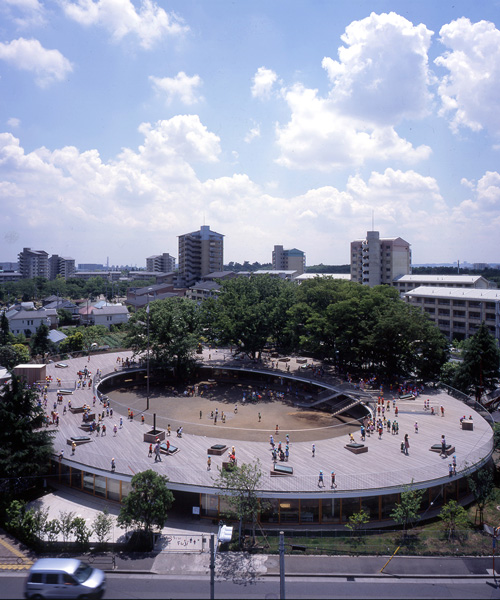japanese practice tezuka architects has won the 2017 moriyama RAIC international prize for its oval-shaped kindergarten in tokyo. the award is given every two years in recognition of a single work of architecture that is judged to be ‘transformative within its societal context and expressive of the humanistic values of justice, respect, equality and inclusiveness.’ the project was chosen ahead of BIG’s ‘8 house’ in copenhagen; the melbourne school of design by john wardle architects and NADAAA; and the shobac campus in nova scotia, canada, by mackay-lyons sweetapple architects. in total, the prize received submissions from 17 countries across six continents.

the oval-shaped kindergarten is located in tokyo
image by katsuhisa kida (also main image)
the ‘fuji kindergarten’ was announced as the winner of the 2017 moriyama RAIC international prize by the royal architectural institute of canada at a ceremony in toronto. the project — a one-story, oval-shaped facility that can accommodate more than 600 children — has been designed for a climate that allows the children to be outdoors for much of the year. the building is topped with an elliptical open-air roof, with classrooms, offices, and support spaces below.

the one-story facility can accommodate more than 600 children
image by katsuhisa kida
‘what we want to teach through this building are values of human society that are unchanging, even across eras,’ explains tezuka architects. ‘we want the children raised here to grow into people who do not exclude anything or anyone. the key to fuji kindergarten was to design spaces as very open environments, filled with background noise. when the boundary disappears, the constraints disappear. children need to be treated as a part of the natural environment.’

three pre-existing trees are incorporated into the design of the school
image by katsuhisa kida
three pre-existing trees were incorporated into the design of the school, emerging through the structure for children to climb on. the openings are protected by heavy nets, which offer views of the playground below. the architectural details were designed at the scale of a child, from the handrail to the door fittings. ‘the space by tezuka architects took a new look at kindergartens,’ said the competition jury. ‘there is no hierarchy to the place; the teachers and the kids all have an equal status architecturally, which is a direct result of the form and the way the whole building opens up. it is an egalitarian, comfortable, and physically stimulating place for children.’

internal spaces spill out onto a central courtyard
image by katsuhisa kida
‘it is a pleasure to congratulate the winner of the second moriyama RAIC international prize and to recognize their devotion to architecture that imagines new possibilities for people,’ said raymond moriyama, who established the award along with the RAIC and the RAIC foundation in 2014. ‘this is a prize that will continue to acknowledge the important work of transformative architecture worldwide and its designers. no matter the scale or size of the building, the prize provides an opportunity to recognize design qualities which make a positive contribution.’

the building is topped with an elliptical open-air roof
image by katsuhisa kida
the prize consists of a monetary award of CAD $100,000 and a sculpture created by canadian designer wei yew. it celebrates a single work of architecture that is judged to be transformative within its societal context and reflects moriyama’s conviction that great architecture transforms society by promoting social justice and humanistic values of respect and inclusiveness. presented every two years, the award is open to all architects, irrespective of nationality and location, and the winner is selected in an open, juried competition.
Save
Save
Save
Save
Save
Save
Save
Save
Save
Save
Save
Save
Save






















